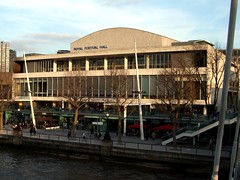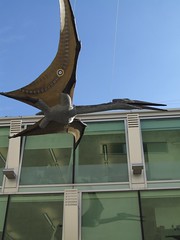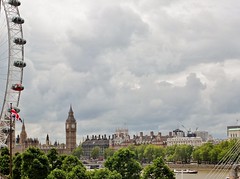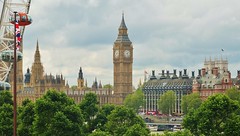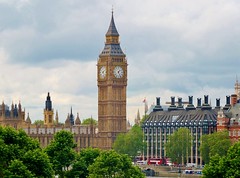Royal Festival Hall
The Royal Festival Hall is a 2,700-seat concert, dance and talks venue within Southbank Centre in London. It is situated on the South Bank of the River Thames, not far from Hungerford Bridge, in the London Borough of Lambeth. It is a Grade I listed building, the first post-war building to become so protected (in 1981). The London Philharmonic Orchestra, the Philharmonia Orchestra, the Orchestra of the Age of Enlightenment, the London Sinfonietta, Chineke! and Aurora are resident orchestras at Southbank Centre.
The hall was built as part of the Festival of Britain for London County Council, and was officially opened on 3 May 1951. When the LCC's successor, the Greater London Council, was abolished in 1986, the Festival Hall was taken over by the Arts Council, and managed together with the Queen Elizabeth Hall and Purcell Room (opened 1967) and the Hayward Gallery (1968), eventually becoming an independent arts organisation, now known as the Southbank Centre, in April 1998.
The complex includes several reception rooms, bars and restaurants, and the Clore Ballroom, accommodating up to 440 for a seated dinner. A large head and shoulders bust of Nelson Mandela (by Ian Walters, created in 1985) stands on the walkway between the hall and Hungerford Bridge approach viaduct. Originally made in glass-fibre it was repeatedly vandalised until re-cast in bronze.
The complex's variety of open spaces and foyers are popular for social or work-related meetings.
The closest tube stations are Waterloo and, across the river via the Jubilee Bridges, Embankment and Charing Cross.
The original building
The Festival Hall project was led by London County Council's chief architect, Robert Matthew, who gathered around him a young team of talented designers including Leslie Martin, who was eventually to lead the project with Edwin Williams and Peter Moro, along with the furniture designer Robin Day and his wife, the textile designer Lucienne Day. The acoustical consultant was Hope Bagenal, working with members of the Building Research Station; Henry Humphreys, Peter Parkin and William Allen. Martin was 39 at the time, and very taken with the Nordic activities of Alvar Aalto and Gunnar Asplund.
The figure who really drove the project forward was Herbert Morrison, the Labour Party politician. It was he who had insisted that Matthew had Martin as his deputy architect, treating the Festival Hall as a special project.
Architecture
A 1948 sketch by Martin shows the design of the concert hall as the egg in a box. But the strength of the design was the arrangement of interior space: the central staircase has a ceremonial feel and moves elegantly through the different levels of light and air.
They were concerned that whilst the scale of the project demanded a monumental building, it should not ape the triumphal classicism of many earlier public buildings. The wide open foyers, with bars and restaurants, were intended to be meeting places for all: there were to be no separate bars for different classes of patron. Because these public spaces were built around the auditorium, they also had the effect of insulating the Hall from the noise of the adjacent railway bridge.
To quote Leslie Martin, "The suspended auditorium provides the building with its major attributes: the great sense of space that is opened out within the building, the flowing circulation from the symmetrically placed staircases and galleries that became known as the 'egg in the box'."
The hall they built used modernism's favourite material, reinforced concrete, alongside more luxurious elements including beautiful woods and Derbyshire fossilised limestone. The exterior of the building was bright white, intended to contrast with the blackened city surrounding it. Large areas of glass on its façade meant that light coursed freely throughout the interior, and at night, the glass let the light from inside flood out onto the river, in contrast to the darkness which befell the rest of London after dusk.
The hall originally seated 2,901. The cantilevered boxes are often described as looking like drawers pulled out in a hurried burglary, but none has a compromised sightline. The ceiling was wilfully sculptural, a conceit at the very edge of building technology and, as it turns out, way beyond the contemporary understanding of acoustics. Robin Day, who designed the furniture for the auditorium, used a clearly articulated structure in his designs of bent plywood and steel.
The original building had lushly planted roof terraces; the Level Two foyer café had been able to spill out onto the terraces looking out on the river, and original entrances were positioned on the sides of the building, enabling visitors to arrive directly at the stairs leading to the auditorium.
The foundation stone was laid in 1949 by Prime Minister Clement Attlee on the site of the former Lion Brewery, built in 1837. The building was constructed by Holland, Hannen & Cubitts at a cost of £2 million and officially opened on 3 May 1951 with a gala concert attended by King George Vl and Queen Elizabeth, conducted by Sir Malcolm Sargent and Sir Adrian Boult. The first general manager was T. E. Bean, who had previously managed the Hallé Orchestra.
"I was overwhelmed by a shock of breathless delight at the originality and beauty of the interior. It felt as if I had been instantly transported far into the future and that I was on another planet," said journalist Bernard Levin of his first impressions of the building.
Organ
The 7,866 pipe organ was built during 1950–1954 by Harrison & Harrison in Durham, to the specification of the London County Council's consultant, Ralph Downes, who also supervised the tonal finishing. It was designed as a well-balanced classical instrument embracing a number of rich and varied ensembles which alone or in combination could equal the dynamic scale of any orchestra or choral grouping, in addition to coping with the entire solo repertoire.
The design principles enshrined in its construction gave rise to a whole new school of organ building, known as the English Organ Reform Movement, influencing in the UK alone the cathedral organs of Coventry and Blackburn and the concert hall organs of the Fairfield Halls, Croydon, and the Bridgewater Hall, Manchester: there are also innumerable organs in other countries which have been influenced by it.
However, the design of the organ in its housing made maintenance difficult, and by 2000 it had become unusable. It was consequently completely removed before restoration of the Hall itself began in 2005, and after restoration and updating by Harrison & Harrison, a third of the organ was reinstalled. The remainder was reinstalled between 2012 and 2013, and voicing completed in 2014.
Acoustics
The Festival Hall was one of the first concert halls in the world to be built using the application of scientific principles, both theoretical and experimental. Hope Bagenal and his colleagues from the Building Research Station formed an integral part of the design team. The acoustic behaviour of the seats was measured and tested in a laboratory to enable more exacting design. Careful consideration of external noise problems was undertaken.
Following the opening of the hall, there was some criticism of certain aspects of the acoustics. This was partially attributable to the fact that some of the original specifications for room surfaces determined by the acoustic consultants were ignored in the building process. A specific problem for performers was the difficulty of hearing each other on the platform. Both the angled 'blast' side walls and the plywood reflectors projected sound away from the stage.
The general consensus was that the hall was 'too dry', not reverberant enough, particularly at low frequencies, and that the bass tone was weak. The definition was 'excellent' for chamber and modern music, but the hall was not as effective for music of the late Classical or Romantic period. Sir John Barbirolli commented, "Everything is sharp and clear and there is no impact, no fullness on the climaxes."
Heating systems
A ground source heat pump was used to heat the building in the winter and cool the building in the summer. Water was extracted from the River Thames below Hungerford Bridge using a centrifugal pump. Heat was extracted from the river water using a heat pump. The compressors were driven by two Rolls-Royce Merlin engines, adapted to run on town gas. It was highly successful, providing both heating and cooling for the Hall, but over-sized, and was sold off after the Festival of Britain.
The 1964 alterations
As a structure, the new Festival Hall was technically stretched, and maintenance was soon required. The building was substantially altered in 1964 by adding the foyers and terraces to the river side of the building, extending the footprint by 30 ft, and more dressing rooms to the rear. Alterations to the façades overlooking the river removed the decorative tiles, altering the Scandinavian Modernism of the building's primary public face in favour of a plainer and hard-edged style. The building's original entrance sequence was much compromised by these changes and the later additions of raised concrete walkways around the building to serve the neighbouring Queen Elizabeth Hall, Purcell Room and The Hayward, built in 1967/8.
Assisted resonance
Leo Beranek, an American acoustics engineer who had undertaken measurements of all of the world's leading concert halls, had identified that the interior treatment of the auditorium was absorbing too much sound. By 1962 the authorities, after prolonged experiment, had become convinced that no improvement in the hall's reverberation could be achieved by any further treatment of its surfaces. Longer reverberation would require modification to the main structure, reducing the seating capacity and the provision of a new ceiling. This was considered too costly, particularly as any hypothetical gain in 'warmth' or 'resonance' might well be by the sacrifice …
Looking for places related to Royal Festival Hall?
Those are other destinations to find places related to Royal Festival Hall:
- Westminster Bridge
- London Eye
- Big Ben
- Waterloo Bridge
- Royal National Thea…
- Hungerford Bridge a…
- Royal Festival Hall
- Victoria Embankment
- Southbank Centre
- Jubilee Gardens, La…
- Adelphi, London
- Queen Elizabeth Hall
- Ministry of Defence
- Battle of Britain M…
- Benjamin Franklin H…
- The Old Vic
- Portcullis House
- Michael Faraday
- Shell Centre
- Courtauld Institute…
- Simpson's-in-the-St…
- Savoy Theatre
- Savoy Palace
- Hayward Gallery


